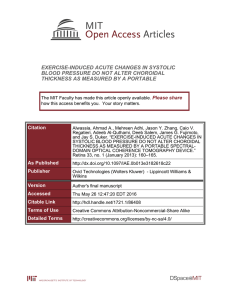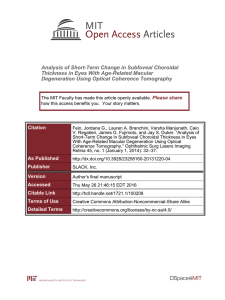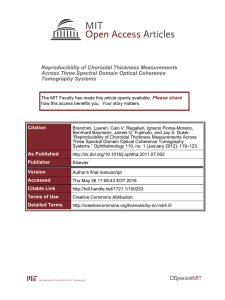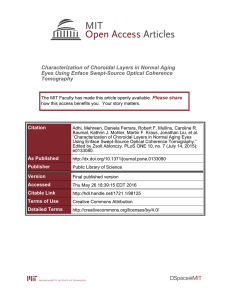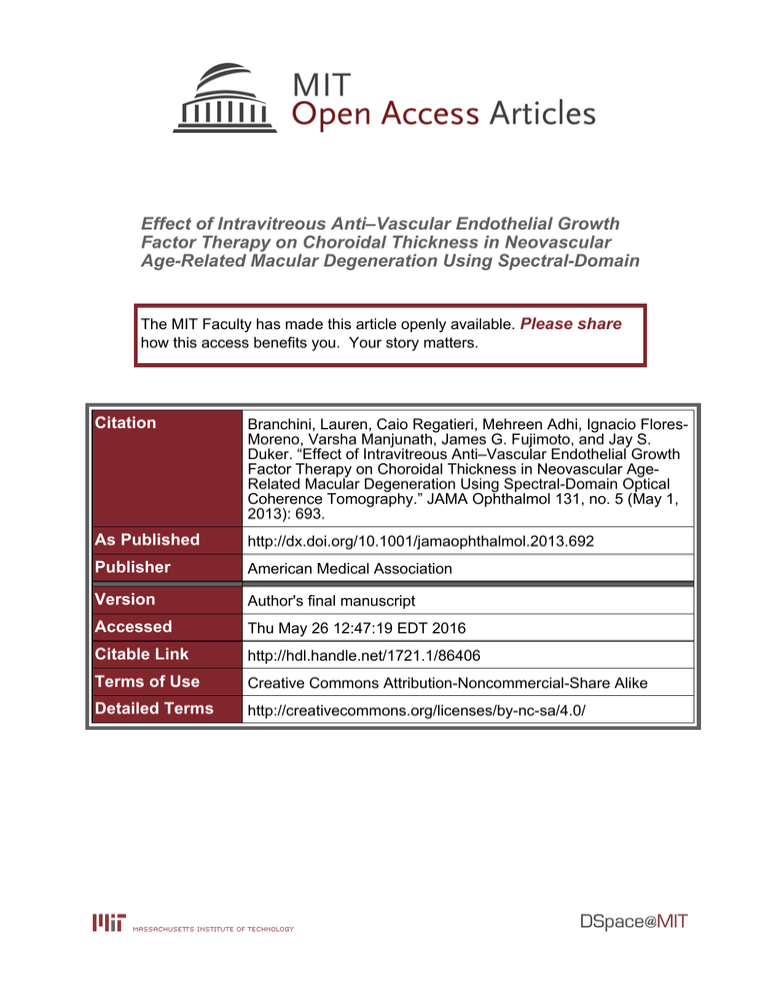
Effect of Intravitreous Anti–Vascular Endothelial Growth
Factor Therapy on Choroidal Thickness in Neovascular
Age-Related Macular Degeneration Using Spectral-Domain
The MIT Faculty has made this article openly available. Please share
how this access benefits you. Your story matters.
Citation
Branchini, Lauren, Caio Regatieri, Mehreen Adhi, Ignacio FloresMoreno, Varsha Manjunath, James G. Fujimoto, and Jay S.
Duker. “Effect of Intravitreous Anti–Vascular Endothelial Growth
Factor Therapy on Choroidal Thickness in Neovascular AgeRelated Macular Degeneration Using Spectral-Domain Optical
Coherence Tomography.” JAMA Ophthalmol 131, no. 5 (May 1,
2013): 693.
As Published
http://dx.doi.org/10.1001/jamaophthalmol.2013.692
Publisher
American Medical Association
Version
Author's final manuscript
Accessed
Thu May 26 12:47:19 EDT 2016
Citable Link
http://hdl.handle.net/1721.1/86406
Terms of Use
Creative Commons Attribution-Noncommercial-Share Alike
Detailed Terms
http://creativecommons.org/licenses/by-nc-sa/4.0/
NIH Public Access
Author Manuscript
JAMA Ophthalmol. Author manuscript; available in PMC 2013 September 10.
NIH-PA Author Manuscript
Published in final edited form as:
JAMA Ophthalmol. 2013 May ; 131(5): 693–694. doi:10.1001/jamaophthalmol.2013.692.
Effect of Intravitreous Anti–Vascular Endothelial Growth Factor
Therapy on Choroidal Thickness in Neovascular Age-Related
Macular Degeneration Using Spectral-Domain Optical Coherence
Tomography
NIH-PA Author Manuscript
Lauren Branchini, MD, Caio Regatieri, MD, PhD, Mehreen Adhi, MBBS, Ignacio FloresMoreno, MD, Varsha Manjunath, MD, James G. Fujimoto, PhD, and Jay S. Duker, MD
Department of Ophthalmology, New England Eye Center, Tufts Medical Center, Boston (Drs
Branchini, Regatieri, Adhi, Manjunath, and Duker) and Department of Electrical Engineering and
Computer Science, Research Laboratory of Electronics, Massachusetts Institute of Technology,
Cambridge (Dr Fujimoto); and Department of Ophthalmology, University Hospital of Albacete,
Albacete, Spain (Dr Flores-Moreno).
A critical method of monitoring patients with neovascular age-related macular degeneration
(AMD) being treated with anti–vascular endothelial growth factor (anti-VEGF) is optical
coherence tomography (OCT), which uses low-coherence interferometry of light to examine
the retina in vivo on a micrometer scale.1
Recent advances in spectral-domain OCT make visualization of the choroid feasible. Using
image averaging and enhanced depth imaging, successful examination and measurement of
choroidal thickness in normal and pathologic states have been reported.2–4
It has been hypothesized that anti-VEGF may affect choroidal vasculature.5 The goal of this
study is to evaluate the effect of anti-VEGF on choroidal thickness using spectral-domain
OCT in treatment-naive subjects.
Methods
NIH-PA Author Manuscript
Twenty-two patients (22 eyes) with neovascular AMD were identified prior to first-time
treatment with anti-VEGF at New England Eye Center. All patients with concomitant ocular
pathologies were excluded. Twenty age-matched healthy eyes were identified as a control
group. This study was approved by the institutional review board of the Tufts Medical
Center.
Patients were imaged with spectral-domain OCT prior to first-time treatment with antiVEGF therapy and again at 3, 6, and 12 months (Figure 1). Control eyes were imaged at the
time of identification and 6 months later. The scan pattern used was Cirrus high-definition 1line raster (Carl Zeiss Meditec), which is a 6-mm line consisting of 4096 A-scans and 20 Bscans averaged together without tracking.
©2013 American Medical Association. All rights reserved.
Correspondence: Dr Duker, New England Eye Center, 800 Washington St, Boston, MA 02111 (jduker@tuftsmedicalcenter.org).
Author Contributions: Dr Duker had full access to all the data in the study and takes responsibility for the integrity of the data and
the accuracy of the data analysis.
Conflict of Interest Disclosures: Dr Fujimoto receives royalties from intellectual property owned by Massachusetts Institute of
Technology and licensed to Carl Zeiss Meditech Inc and has stock options in Optovue Inc. Dr Duker receives research support from
Carl Zeiss Meditech Inc, Optovue Inc, and Topcon Medical Systems Inc.
Branchini et al.
Page 2
NIH-PA Author Manuscript
Choroidal thickness was manually measured at 500-µm intervals, 2500 µm temporal and
nasal to the fovea. Measurements were performed by 2 independent observers with a strong
interobserver correlation (r = 0.97; P < .001). Two-way analysis of variance with Tukey
multiple test was applied using Prism Mac 5.0 statistical software (GraphPad Software, Inc).
Results
A total of 22 eyes of 22 patients (11 male, 11 female) were included. The mean age was 79
years (range, 66–88 years). Five patients were lost to follow-up. Anti-VEGF therapy was not
delivered in a standard fashion. Most eyes were treated with a “treat and extend” protocol.
Fifteen patients were treated with ranibizumab and 7 were treated with bevacizumab. The
average number of anti-VEGF treatments was 6.9 (range, 2–12). No correlation was found
between the number of treatments and a decrease in choroidal thickness.
The mean (SD) subfoveal choroidal thickness at baseline and 3, 6, and 12 months’ follow-up
was 207.4 (22.1) µm, 194.7 (21.9) µm (P > .05), 164.9 (18.0) µm (P < .05), and 171.8 (17.4)
µm (P < .05), respectively (Figure 2). The mean (SD) subfoveal choroidal thickness in the
control group was 253.5 (4.1) µm at the first measurement and 255.3 (4.2) µm at 6 months
(P = .72).
NIH-PA Author Manuscript
Comment
This study demonstrates significant choroidal thinning after 6 and 12 months of anti-VEGF
treatment for neovascular AMD. Control eyes demonstrated no decrease in choroidal
thickness over 6 months.
Histopathology of AMD is characterized by attenuation of the Bruch membrane and
degeneration of the choriocapillaris.6 This suggests that there may be a component of
choroidopathy in neovascular AMD. If antiangiogenic therapy affects the choroid, treatment
could potentially have unforeseen adverse effects.
It is unclear whether the observed decrease in choroidal thickness is a consequence of antiVEGF treatment or a component of AMD. Greater numbers of subjects are necessary to
determine whether there is a dose response. Another limitation to this prospective
investigation was that there was no standard protocol for the initiation of therapy or the
timing and number of injections.
NIH-PA Author Manuscript
The use of anti-VEGF for the treatment of neovascular AMD has been shown to improve
visual acuity and is currently being used extensively for this purpose. In our study, there was
significant thinning of the choroid in patients with neovascular AMD treated with antiVEGF. This may have implications for long-term choroidal function.
Acknowledgments
Funding/Support: This work was supported in part by an unrestricted grant from Research to Prevent Blindness to
the New England Eye Center and Department of Ophthalmology, Tufts University School of Medicine, by grants
R01-EY11289-25, R01-EY13178-10, R01-EY013516-07, and R01-EY019029-02 from the National Institutes of
Health and FA9550-10-1-0551 and FA9550-10-1-0063 from the Air Force Office of Scientific Research, and by the
Massachusetts Lions Clubs.
References
1. Huang D, Swanson EA, Lin CP, et al. Optical coherence tomography. Science. 1991; 254(5035):
1178–1181. [PubMed: 1957169]
JAMA Ophthalmol. Author manuscript; available in PMC 2013 September 10.
Branchini et al.
Page 3
NIH-PA Author Manuscript
2. Spaide RF, Koizumi H, Pozzoni MC. Enhanced depth imaging spectral-domain optical coherence
tomography. Am J Ophthalmol. 2008; 146(4):496–500. [PubMed: 18639219]
3. Manjunath V, Taha M, Fujimoto JG, Duker JS. Choroidal thickness in normal eyes measured using
Cirrus HD optical coherence tomography. Am J Ophthalmol. 2010; 150(3):325–329. e1. [PubMed:
20591395]
4. Imamura Y, Fujiwara T, Margolis R, Spaide RF. Enhanced depth imaging optical coherence
tomography of the choroid in central serous chorioretinopathy. Retina. 2009; 29(10):1469–1473.
[PubMed: 19898183]
5. Saint-Geniez M, Kurihara T, Sekiyama E, Maldonado AE, D’Amore PA. An essential role for RPEderived soluble VEGF in the maintenance of the choriocapillaris. Proc Natl Acad Sci U S A. 2009;
106(44):18751–18756. [PubMed: 19841260]
6. Lutty G, Grunwald J, Majji AB, Uyama M, Yoneya S. Changes in choriocapillaris and retinal
pigment epithelium in age-related macular degeneration. Mol Vis. 1999; 5:35. [PubMed: 10562659]
NIH-PA Author Manuscript
NIH-PA Author Manuscript
JAMA Ophthalmol. Author manuscript; available in PMC 2013 September 10.
Branchini et al.
Page 4
NIH-PA Author Manuscript
NIH-PA Author Manuscript
NIH-PA Author Manuscript
Figure 1.
Spectral-domain optical coherence tomographic scans showing choroidal thicknesses of the
same subject at 4 different times. Image averaging is used for choroidal visualization.
Subfoveal choroidal thickness measurements were taken from the outer edge of the
hyperreflective retinal pigment epithelium to the inner sclera. Red lines indicate subfoveal
choroidal thickness. A, Before treatment with intravitreous anti–vascular endothelial growth
factor. B, Three months after treatment with intravitreous anti–vascular endothelial growth
factor. C, Six months after treatment with intravitreous anti–vascular endothelial growth
factor. Note the decrease in choroidal thickness. D, Twelve months after treatment with
JAMA Ophthalmol. Author manuscript; available in PMC 2013 September 10.
Branchini et al.
Page 5
intravitreous anti–vascular endothelial growth factor. Note the decrease in choroidal
thickness.
NIH-PA Author Manuscript
NIH-PA Author Manuscript
NIH-PA Author Manuscript
JAMA Ophthalmol. Author manuscript; available in PMC 2013 September 10.
Branchini et al.
Page 6
NIH-PA Author Manuscript
NIH-PA Author Manuscript
Figure 2.
Mean choroidal thickness over all locations measured in 500-µm intervals, 2500 µm
temporal (T) and nasal (N) to the fovea before treatment and 3, 6, and 12 months after the
first treatment. Note that the N measurements are thinnest where the T measurements are
thickest. The numbers next to the T and N locations indicate millimeters.
NIH-PA Author Manuscript
JAMA Ophthalmol. Author manuscript; available in PMC 2013 September 10.









